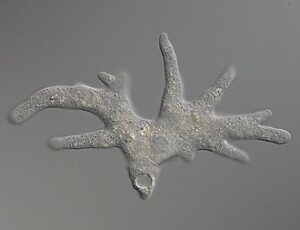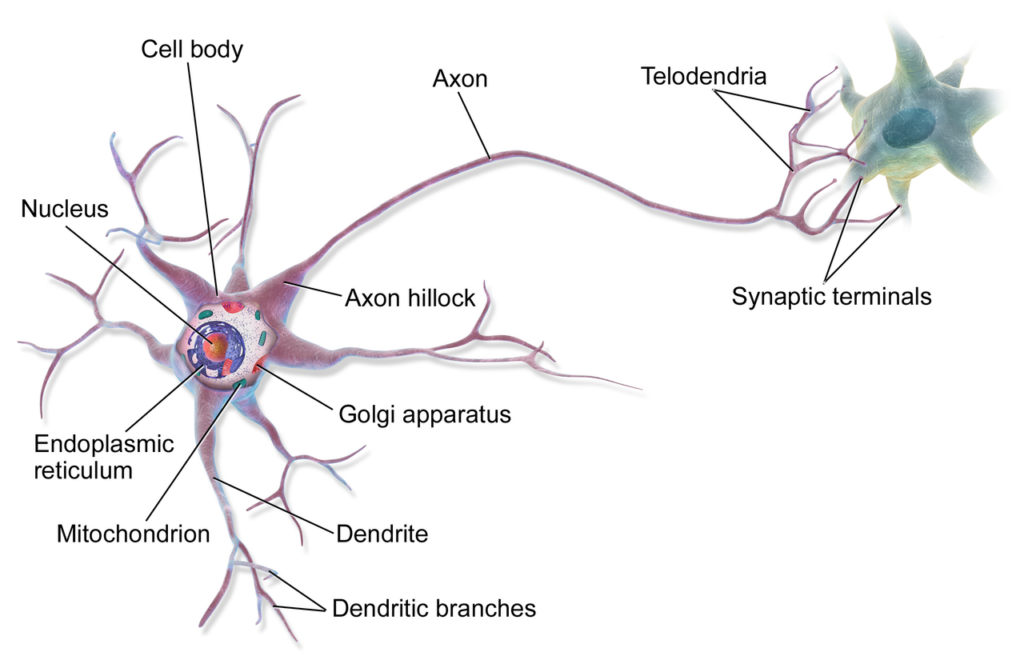Cells that have a defined nucleus with the genetic material in them are called eukaryotic cells.
Originating from the Greek words “Eu” meaning “true” and karyon meaning nut or “kernel,” the word Eukaroun means actual kernel or nucleus. So eukaryotic cells refer to those cells with a membrane-bound nuclear material instead of floating around the cell cytoplasm.
Eukaryotes comprise plants, animals, protists, and fungi. Generally, their genetic material or DNA is found assembled in the nucleus, which is again surrounded by a nuclear membrane. They also have several other membrane-bound organelles that have specific functions. This is the main feature that distinguishes eukaryotes from prokaryotes-like bacteria. Bacterial cells do not have any cell organelles as such, and their genetic material, which can be RNA or DNA, just randomly floats about in the cytoplasm.
Eukaryotic cells include:
EUKARYOTIC CELLS EXAMPLES:
PROTISTA:
Eukaryotic organisms that are not plants, fungi, or animals, so they are categorized in a biological kingdom are classified as protists. The organisms are so diverse that they can be more closely related to a fungus, plant, or animal cell rather than another Protista. These mainly include bacteria, amoeba, or algae.
AMOEBA:
Also called amoeboid is a unicellular eukaryotic cell closely related to animal cells. This means they do not have a cell wall and can change their shape, which gives them the ability to move from one place to another. They can extend their cell wall to make leg-like appendages called pseudopodia(“pseudo” meaning false; “podia” representing feet) and use them to move forward. They also contain a membrane-bound nucleus with granular DNA.
E.g., Amoeba proteus.

Image credit: Wikipedia
DINOFLAGELLATE:
They make up a phylum called Dinoflagellata and are considered algae. They are a form of marine eukaryotic unicellular organism. They have a flagellum (a whip-like structure) used for locomotion which gives it its name -Dinos(Greek word whirling) and Latin Flagallae. These organisms often exhibit a phenomenon called Biolumenesence- a natural light produced by living organisms using an internal chemical reaction. These are primarily marine plankton but can also occur in freshwater. These organisms, like plants, can photosynthesize and are responsible for the significant amount of oxygen that is produced by our oceans.
E.g., Noctiluca scintillans – A marine species that can occur in red or green forms depending on the nature of the present pigment.

Image credit: Wikipedia
PLASMODIUM
Several species of this protozoa are parasitic and can cause life-threatening diseases. These include P.vivax and P.falciparum, which both cause different types of malaria in humans.

Image: Wikipedia
FUNGI
Another group of eukaryotic organisms most distinguishable to us from the mushrooms we eat is the yeast that goes into our bread dough or the mold that grows on that very bread spoiling it. Though considered plants, they cannot photosynthesize due to the absence of chlorophyll, hence developing a saprophytic lifestyle.
YEAST
The powder we regularly add to our bread and cake doughs is made of a unicellular eukaryotic fungus. Also, being used in wine and beer making has earned this genus the name of brewer’s and baker’s yeast. These organisms are saprophytic, i.e., they use the sugars in the dough and use it as food and release carbon dioxide as a result which causes the dough to rise. Fungi also have cell walls, but these are composed of chitin instead of the usual cellulose as in plants.
PLANT CELLS
Plant cells are one of the most abundant among eukaryotes. These cells have some specific characters, including the presence of a cell wall and the presence of a pigment-containing organelle. The cell wall is usually composed of cellulose and gives plant cells the ability to retain their shape. The pigment-containing organelle is what allows plants to photosynthesize. This pigment can be of many types.
Two layers cover the basic unit of plants- a cellulose-made cell wall and a phospholipid bilayer cell membrane. The most distinguishing factor is the presence of chloroplast, a type of plastid (a double membrane-bound organelle) that contains pigments that can convert Carbon dioxide and water to produce glucose and oxygen. There are other plastids as well that serve different functions.
Types of plastids in plants:
- Chloroplasts: these are found in all the mesophyll cells in the green tissues of plants. They contain the green pigment that gives plants their characteristic green color and allows them to photosynthesize. Non-green plants can synthesize too, but the chemical reaction is different.
- Chromoplasts: These contain other pigments, excluding green. Chloroplasts turn to chromo as the plant matures. Found in flowers, fruits, and non-green leaves. These contain orange, red and yellow pigments. These are the pigments that make flowers visually appealing.
- Leucoplast: Non-pigmented plastids their primary function is storage instead of synthesis. They are of 3 main types:
- Amyloplast: They are the most abundant and are used in starch storage.
- Alaioplast: These organelles store oils and fatty acids that are required by the plant cells.
- Proteinoplast: As suggested by the name, they are protein storage vessels. These are primarily found in seeds- the very reason legumes and pulses are considered a rich protein source.
Another characteristic of plant cells is the presence of large vacuoles. Unlike other organisms, one or more vacuoles can be present in a single cell.
TYPES OF PLANT CELLS:
- Parenchyma cells
- Collenchyma cells
- Sclerenchyma cells
- Xylem cells
- Phloem cells
- Meristematic cells
- Epidermal cells

Image credit: Wikipedia
ANIMAL CELLS
Animal cells are the most commonly found cells among the eukaryotes. Unlike plants, they are only covered by a lipid bilayer, making them semipermeable. This means it allows the cells to exchange materials in liquid and gaseous forms. Being devoid of a cell wall also means that animal cells do not have a fixed shape, and they vary in shape even in a single organism.
The last and the most visible kind of eukaryotic cells found in nature. They have a membrane-bound nucleus and also other membrane-bound organelles that have specific functions. Since animal cells spend more energy, it is common to see a greater concentration of mitochondria compared to plant cells.
SOME SPECIFIC ANIMAL CELLS:
Neurons: Unlike most normal cells, nerve cells or neurons are distinguishable because of their strange shape. Used to transmit stimuli in the form of electrochemical signals, unlike other cells, they are constantly not produced throughout life. Unlike most animal cells that communicate via their cell membranes, neurons connect to other neurons via unique connections called synapses. These synapses are different as a thin membrane covers them to protect the delicate neuron ends and ensure the links remain stable.

Image: Wikipedia
Red Blood cells or RBCs: Red blood cells are biconcave, but unlike other eukaryotic cells, they do not have a nucleus. This, along with their shape, allows for maximum gaseous absorption. They have an iron-containing pigment called hemoglobin which binds to the oxygen and carbon dioxide molecules to transport them through the body.
Also Read:
- Pendulum examples
- Ecosyetm examples
- Kinetic friction examples
- Rolling friction examples
- Alloy examples
- Physical change heat examples
- Intermolecular forces examples
- Anaerobic respiration examples
- Parallel lines examples
- Magnetic force examples detailed insights

I am Trisha Dey, a postgraduate in Bioinformatics. I pursued my graduate degree in Biochemistry. I love reading .I also have a passion for learning new languages.
Let’s connect through linked in: